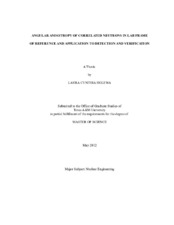| dc.description.abstract | It has been shown that neutrons emitted from the same 252Cf fission event are preferentially detected within small angles of each other and at angles around 180 degrees. The distribution of this angular anisotropy is dependent upon the nuclide emitting the neutrons. Coincident neutrons can be detected from a shielded source, so a study of the angular anisotropy between coincident neutrons is useful for this context. This could allow for the dynamic determination of the ratio of the rate of (alpha,n) neutron production to the spontaneous fission neutron production (designated alpha) used in neutron coincidence counting for safeguards. This could also be used to identify neutron emitting isotopes in a homeland security application.
An angular frequency distribution for coincident neutrons was produced via experiments using an array of cylindrical liquid scintillators and a 252Cf source. It was found, in accordance with previous experiments, that the angular frequency distribution peaks at small angles and at angles around 180 degrees. A Monte Carlo, physics-based simulation program was created to simulate the distribution of angles between neutrons from the same fission event from 252Cf and 240Pu sources. The resulting distributions were clearly distinguishable from each other. The code was benchmarked to measured results from a 252Cf source at Lawrence Livermore National Laboratory. Knowledge of the unique angular distributions of coincident neutrons from various fissioning sources is useful for identification and verification purposes. Another practical application of angular anisotropy information for coincident neutrons from a given source is determining the ratio of the (alpha,n) to spontaneous fission rates for a source undergoing neutron coincidence counting. The utility of this was verified by using measurements made by faculty and students of the University of Michigan Nuclear Engineering Department for a MOX fuel pin at the Joint Research Center in Ispra, Italy. Good agreement between the predicted and declared values for alpha was found. | en |


